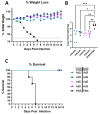Adenoviral-Vectored Centralized Consensus Hemagglutinin Vaccine Provides Broad Protection against H2 Influenza a Virus
- PMID: 35746534
- PMCID: PMC9229510
- DOI: 10.3390/vaccines10060926
Adenoviral-Vectored Centralized Consensus Hemagglutinin Vaccine Provides Broad Protection against H2 Influenza a Virus
Abstract
Several influenza pandemics have occurred in the past century, one of which emerged in 1957 from a zoonotic transmission of H2N2 from an avian reservoir into humans. This pandemic caused 2-4 million deaths and circulated until 1968. Since the disappearance of H2N2 from human populations, there has been waning immunity against H2, and this subtype is not currently incorporated into seasonal vaccines. However, H2 influenza remains a pandemic threat due to consistent circulation in avian reservoirs. Here, we describe a method of pandemic preparedness by creating an adenoviral-vectored centralized consensus vaccine design against human H2 influenza. We also assessed the utility of serotype-switching to enhance the protective immune responses seen with homologous prime-boosting strategies. Immunization with an H2 centralized consensus showed a wide breadth of antibody responses after vaccination, protection against challenge with a divergent human H2 strain, and significantly reduced viral load in the lungs after challenge. Further, serotype switching between two species C adenoviruses enhanced protective antibody titers after heterologous boosting. These data support the notion that an adenoviral-vectored H2 centralized consensus vaccine has the ability to provide broadly cross-reactive immune responses to protect against divergent strains of H2 influenza and prepare for a possible pandemic.
Keywords: H2N2; adenovirus; consensus; influenza; species C; vaccine.
Conflict of interest statement
The authors declare no conflict of interest.
Figures




Similar articles
-
Evaluation of three live attenuated H2 pandemic influenza vaccine candidates in mice and ferrets.J Virol. 2014 Mar;88(5):2867-76. doi: 10.1128/JVI.01829-13. Epub 2013 Dec 26. J Virol. 2014. PMID: 24371061 Free PMC article.
-
Computationally Optimized Broadly Reactive H2 HA Influenza Vaccines Elicited Broadly Cross-Reactive Antibodies and Protected Mice from Viral Challenges.J Virol. 2020 Dec 22;95(2):e01526-20. doi: 10.1128/JVI.01526-20. Print 2020 Dec 22. J Virol. 2020. PMID: 33115871 Free PMC article.
-
Broadly Reactive H2 Hemagglutinin Vaccines Elicit Cross-Reactive Antibodies in Ferrets Preimmune to Seasonal Influenza A Viruses.mSphere. 2021 Mar 10;6(2):e00052-21. doi: 10.1128/mSphere.00052-21. mSphere. 2021. PMID: 33692193 Free PMC article.
-
H2 influenza viruses: designing vaccines against future H2 pandemics.Biochem Soc Trans. 2019 Feb 28;47(1):251-264. doi: 10.1042/BST20180602. Epub 2019 Jan 15. Biochem Soc Trans. 2019. PMID: 30647144 Review.
-
[Tetravaccine--new fundamental approach to prevention of influenza pandemic].Zh Mikrobiol Epidemiol Immunobiol. 2007 Jul-Aug;(4):15-9. Zh Mikrobiol Epidemiol Immunobiol. 2007. PMID: 17882832 Review. Russian.
Cited by
-
Synthetic Neuraminidase Vaccine Induces Cross-Species and Multi-Subtype Protection.Vaccines (Basel). 2025 Mar 28;13(4):364. doi: 10.3390/vaccines13040364. Vaccines (Basel). 2025. PMID: 40333263 Free PMC article.
-
Epitope-optimized vaccine elicits enduring immunity against swine influenza A virus.Nat Commun. 2025 Apr 30;16(1):4046. doi: 10.1038/s41467-025-59182-7. Nat Commun. 2025. PMID: 40301303 Free PMC article.
-
Immunogenicity and Protective Efficacy of Dose-Sparing Epigraph Vaccine against H3 Swine Influenza A Virus.Vaccines (Basel). 2024 Aug 22;12(8):943. doi: 10.3390/vaccines12080943. Vaccines (Basel). 2024. PMID: 39204066 Free PMC article.
-
Influenza B Virus Vaccine Innovation through Computational Design.Pathogens. 2024 Sep 2;13(9):755. doi: 10.3390/pathogens13090755. Pathogens. 2024. PMID: 39338946 Free PMC article. Review.
-
Inactivated recombinant influenza vaccine: the promising direction for the next generation of influenza vaccine.Expert Rev Vaccines. 2024 Jan-Dec;23(1):409-418. doi: 10.1080/14760584.2024.2333338. Epub 2024 Mar 25. Expert Rev Vaccines. 2024. PMID: 38509022 Free PMC article. Review.
References
-
- Babu T.M., Perera R.A., Wu J.T.K., Fitzgerald T., Nolan C., Cowling B., Krauss S., Treanor J.J., Peiris M. Population Serologic Immunity to Human and Avian H2N2 Viruses in the United States and Hong Kong for Pandemic Risk Assessment. J. Infect. Dis. 2018;218:1054–1060. doi: 10.1093/infdis/jiy291. - DOI - PMC - PubMed
-
- Munster V.J., Baas C., Lexmond P., Waldenstrom J., Wallensten A., Fransson T., Rimmelzwaan G.F., Beyer W.E., Schutten M., Olsen B., et al. Spatial, temporal, and species variation in prevalence of influenza A viruses in wild migratory birds. PLoS Pathog. 2007;3:e61. doi: 10.1371/journal.ppat.0030061. - DOI - PMC - PubMed
Grants and funding
LinkOut - more resources
Full Text Sources
Miscellaneous

